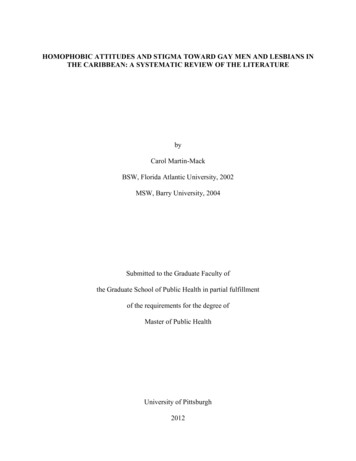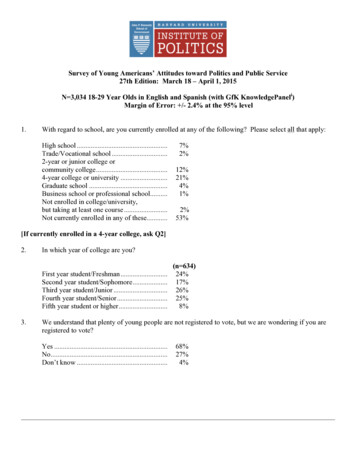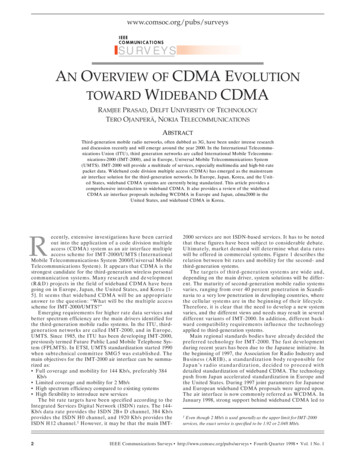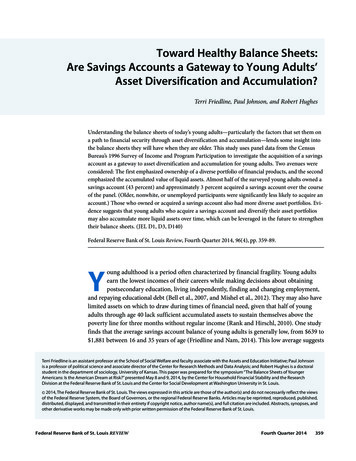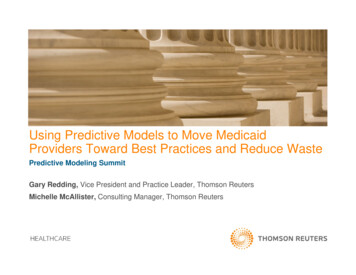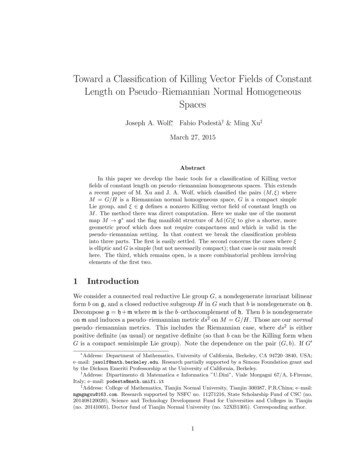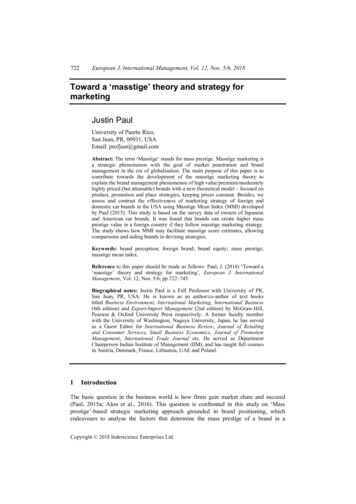
Transcription
722European J. International Management, Vol. 12, Nos. 5/6, 2018Toward a ‘masstige’ theory and strategy formarketingJustin PaulUniversity of Puerto Rico,San Juan, PR, 00931, USAEmail: profjust@gmail.comAbstract: The term ‘Masstige’ stands for mass prestige. Masstige marketing isa strategic phenomenon with the goal of market penetration and brandmanagement in the era of globalisation. The main purpose of this paper is tocontribute towards the development of the masstige marketing theory toexplain the brand management phenomenon of high value/premium/moderatelyhighly priced (but attainable) brands with a new theoretical model – focused onproduct, promotion and place strategies, keeping prices constant. Besides, weassess and contrast the effectiveness of marketing strategy of foreign anddomestic car brands in the USA using Masstige Mean Index (MMI) developedby Paul (2015). This study is based on the survey data of owners of Japaneseand American car brands. It was found that brands can create higher massprestige value in a foreign country if they follow masstige marketing strategy.The study shows how MMI may facilitate masstige score estimates, allowingcomparisons and aiding brands in devising strategies.Keywords: brand perception; foreign brand; brand equity; mass prestige;masstige mean index.Reference to this paper should be made as follows: Paul, J. (2018) ‘Toward a‘masstige’ theory and strategy for marketing’, European J. InternationalManagement, Vol. 12, Nos. 5/6, pp.722–745.Biographical notes: Justin Paul is a Full Professor with University of PR,San Juan, PR, USA. He is known as an author/co-author of text bookstitled Business Environment, International Marketing, International Business(6th edition) and Export-Import Management (2nd edition) by McGraw-Hill,Pearson & Oxford University Press respectively. A former faculty memberwith the University of Washington, Nagoya University, Japan, he has servedas a Guest Editor for International Business Review, Journal of Retailingand Consumer Services, Small Business Economics, Journal of PromotionManagement, International Trade Journal etc. He served as DepartmentChairperson Indian Institute of Management (IIM), and has taught full coursesin Austria, Denmark, France, Lithuania, UAE and Poland.1IntroductionThe basic question in the business world is how firms gain market share and succeed(Paul, 2015a; Alon et al., 2016). This question is confronted in this study on ‘Massprestige’-based strategic marketing approach grounded in brand positioning, whichendeavours to analyse the factors that determine the mass prestige of a brand in aCopyright 2018 Inderscience Enterprises Ltd.
Toward a ‘masstige’ theory and strategy for marketing723society/region/state/country. Mass Prestige is commonly referred to as “masstige,” whichis a marketing term akin to better brand perception and brand equity. A portmanteau ofmass and prestige, the term has been described in layman’s terms as ‘prestige for themasses’ (Silverstein and Fiske, 2003; Truong et al., 2009; Paul; 2015b; Kumar and Paul,2018). The development of masstige strategy and theory flows from a recognition thatmarketing theory is replete with recycled and repeat analyses of different marketing mixelements, but has not grounded well on how and why certain firms build brand equityand achieve international success in this competitive era of globalisation compared toothers.Regarding price and prestige, masstige brands are just a step below traditional luxurybrands and a step above mid-priced brands (Truong et al., 2009). Accordingly, Masstigemarketing can be defined as a phenomenon in which regular products with moderatelyhigh prices are marketed to the maximum number of consumers by creating massprestige without lowering prices or without offering discounts. Starbucks, Apple, Bodyworks or Toyota Lexus etc. are good examples for this approach. Masstige strategyimplies brand positioning, aiming at creating mass prestige value for the brand.Therefore, mid-priced brand managers could also use masstige strategy as it aims atmaximising sales neither by lowering prices nor by offering discount. Product andpromotion strategies play a critical role as part of Masstige marketing. Although“masstige marketing” sounds like a catchy buzzword, this topic has been scarcelyresearched (Truong et al., 2009; Shukla and Purani, 2012; Paul, 2015b; Kumar and Paul,2018), because “masstige” as a term has been coined just a decade ago and adopted bythe academics in the recent past. Thus, there are gaps in the literature, both in the areas ofmeasurement of masstige value, theory development and positioning and linking it withinthe broad spectrum of brand management. Therefore, we contribute to developing‘masstige’ theory and strategy for brand management in this era of globalisation.In tandem with the globalisation of consumer culture, brands have become a focalnotion for both corporations and consumers (Schroeder, 2009). Branding has emerged asa top management priority due to the growing realisation that brands are one of the mostvaluable intangible assets that firms have (Keller and Lehmann, 2006). The globalisationof brands is an evolutionary process that is determined by macro-environmental andfirm-level factors, in the firm’s global brand architecture (Townsend et al., 2010). Forinstance, all leading automotive multinational corporations (MNCs) have engaged inforeign direct investment (FDI) by establishing subsidiaries in foreign countries. Forexample, Japan’s Toyota Motor Corp. (“Toyota”) manufactures cars in Kentucky, USA,due to the firm’s strategy to build a global brand and because of the location’s sizeablemarket. From Toyota’s point of view, there is a need to reach global consumers fasterand reduce production and transportation costs.In a competitive marketplace, the effectiveness of the marketing mix is determinednot only by its absolute value but also by its relative value on the competition (Sudhir,2001). The masstige marketing strategy and measure help explaining the extent ofmarketing success and failure grounded in the approach of building brand prestige, brandlove and brand equity. The concepts of brand prestige and brand love have garnered greatattention in branding and consumer behavior research lately (Nguyen et al., 2013;Schaefer and Kuehlwein, 2015; Paul, 2015b). Despite extensive research and significantadvances in our understanding of brand equity conceptualisation and measurement (e.g.Aaker, 1996; Keller, 1993; Yoo et al., 2000; Yoo and Donthu, 2001; Netemeyer et al.,2004; Pappu et al., 2005), over the last three decades, important questions on brand
724J. Paulequity and likeability remain unanswered (Christodoulides and de Chernatony, 2010;Nguyen et al., 2013). Filling this gap, the present paper examines and compares theeffectiveness of marketing strategy (taking all marketing mix elements together) offoreign brands, Toyota and Honda Motor Co., Ltd. (“Honda”) from Japan (“Foreignbrands”), and domestic automotive brands, General Motors Co. (“GM”) and Ford MotorCo. (“Ford”) in the USA (GM and Ford collectively referred to as “Domestic brands,”and together with Foreign brands referred to as our “Study brands”), by calculating andjuxtaposing their Masstige Mean Index – MMI (Paul, 2015b). We use MMI as analternate method to measure the effectiveness of international marketing strategies thatcreates better brand equity in this study. Besides, we seek to extend the use of MMI(previously used only in the case of ultra-luxury brands such as Luis Vuitton) in thecontext of popular brands with high value/moderately high prices, which are targeted notonly for the high-income group but also middle-income group. Drawing upon Sudhir’s(2001) structural analysis of automobile sector in the USA, an effort has been taken inthis study to estimate the mass prestige value of corporate brands in American carindustry using the Masstige Mean Score Scale (MMSS) and Masstige Mean Index(MMI) developed by Paul (2015b). We present MMI as a tool to examine theeffectiveness of marketing strategy, and as a measure to estimate the relative ‘masstige’value of Japanese and American car brands in the USA, in this study. Thus, the truepurpose of this study is to familiarise the academia with the masstige strategy and itseffectiveness linking with the tenets of strategic management. Accordingly, the scope ofthis study is both building a better theory of marketing performance grounded in the massprestige approach as well as explaining these practical insights for managers.Insights into why consumers differ in their attitudes towards global brands are scant(Riefler, 2012; Steenkamp and de Jong, 2010; Alden et al., 2006b). Besides researchers(Roth et al., 2008; Pappu et al., 2006; Pappu et al., 2007; Pappu and Quester, 2010) showthat country brand equity has a significant effect on consumer’s brand perception andpreferences. However, few or no studies have empirically explored masstige positioningstrategies influence on consumer behaviour (Truong et al., 2009). First, little research hasbeen carried out exploring the masstige strategy so far. Second, not much is known aboutthe relationship between masstige value and the success of a brand. Third, there are noefforts till now to examine the factors affecting the mass prestige and customer-basedbrand equity and their relationship. Fourth, the link between the country of origin andmass prestige of a brand is also under-researched. By addressing these important researchgaps, we make a number of contributions to the literature. First, an effort has been takento conceptualise the theory of masstige marketing. Second, we extend prior research onmasstige marketing, contributing towards building a new theory i.e., a theory of masstigemarketing based on the approaches developed by other experts. Third, we shed light onthe relationship between the mass prestige value, perceived brand equity and countryorigin. Finally, a benchmark parity between a top of mind brand, brand prestige andmasstige value is established with empirical evidence.To fill these gaps in the literature, we extend prior research (Kirmani et al., 1999;Sudhir, 2001; Yoo et al., 2000; Yoo and Donthu, 2001; Roth et al., 2008; Zhou et al.,2010; Pappu and Quester, 2010; Paul, 2015b; Kumar and Paul, 2018), with the specificresearch objectives as follows:
Toward a ‘masstige’ theory and strategy for marketing7251Measure and compare the perceived Mass Prestige value of Foreign versus DomesticCar Brands in the USA using Masstige Mean Index (MMI).2Assess masstige marketing strategy effectiveness and determine which brands aresuccessful, based on their MMI.This article proceeds as follows. The next section is designed towards developing atheory of masstige marketing grounded in the extant masstige marketing literature. Theresearch hypotheses are described in Section 3. The methodology is given in Section 4.Sections 5 and 6 describe the study firms’ brief profile and marketing strategies withreference to product, promotion, and place. Furthermore, Section 7 discusses findings,Section 8 discusses limitations and directions for future research, and Section 9 providesconcluding remarks.2Toward a ‘masstige’ theory and strategyIn this section, an attempt has been made to develop a Masstige theoretical framework,grounded in the extant theoretical models and measures in these areas of research.2.1 Mass prestige and brand managementThe topic of masstige marketing is very important because of the common usage byindustry practitioners, who often employ brand positioning and marketing strategies toincrease market share and profits, particularly in the case of prestige brands as well aspremium brands. Masstige marketing helps in the efforts to create high level of massprestige for the brand in the long run. The examples used by Silverstein and Fiske (2003)in their Harvard Business Review article to coin the term ‘Masstige’ include brands suchas Bath & Body, Victoria’s Secret, Starbucks, and Whirlpool. All of which offer a rangeof prices in their offerings and their customers span various income groups. Hence, it ispossible that masstige strategic approach can be employed in wide variety of brands thatcarry some prestige such as luxury fashion goods, cars, smartphones, laptops, desktopcomputers and star hotels.Chabowski et al. (2013) provide a bibliometric analysis of global branding literatureincorporating five areas with suggestions for the future development of the area. Theareas conceptualised are international branding strategy, brand positioning, brand/countryorigin, brand concept-image, and brand performance. Baek et al. (2010) explored howbrand prestige and brand credibility affected the purchase intention and proposed a modelof six latent constructs. They tested the model with structural equation modelling analysisand found that both brand credibility and brand prestige positively influence purchaseintention through perceived quality, information costs saved, and perceived risk underdifferent product categories that represent the high and low self-expressive nature.The goal of brand positioning and extension is normally to develop a firm’s brandequity, rather than to develop a new product itself (Ambler and Styles, 1997). The massprestige-based brand equity comprises brand symbolism, which is made up, in part, bythe brand’s prestige in the eye of the consumer (Bhat and Reddy, 1998). The brand’sprestige increases the likelihood of a purchase (Steenkamp et al., 2003; Baek et al.,
726J. Paul2010). The leveraging of this prestige and brand equity significantly reduces the costs forthe incumbent firm. This enables the firm to save on costs associated with marketing itsnew brand.Broniarczyk and Alba (1994) show that consumer perception includes the feelingsthat the brand evokes (affect) and how similar it is to the parent brand. Following abroader perspective in exploring customer per
Co. (“Ford”) in the USA (GM and Ford collectively referred to as “Domestic brands,” and together with Foreign brands referred to as our “Study brands”), by calculating and juxtaposing their Masstige Mean Index – MMI (Paul, 2015b). We use MMI as an alternate method to measure the effectiveness of international marketing strategies that


